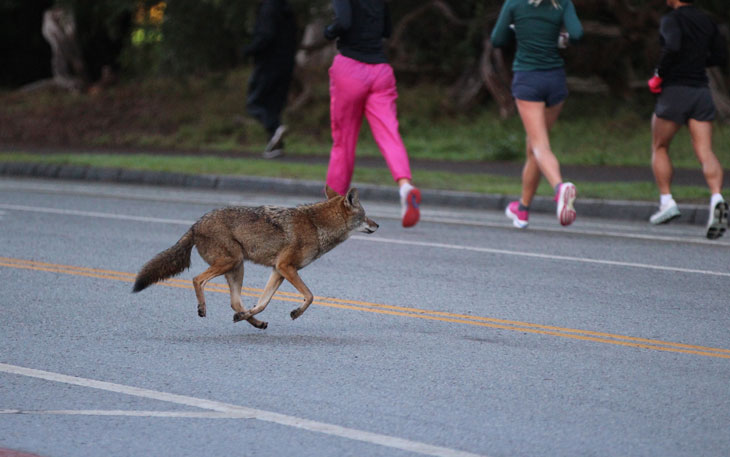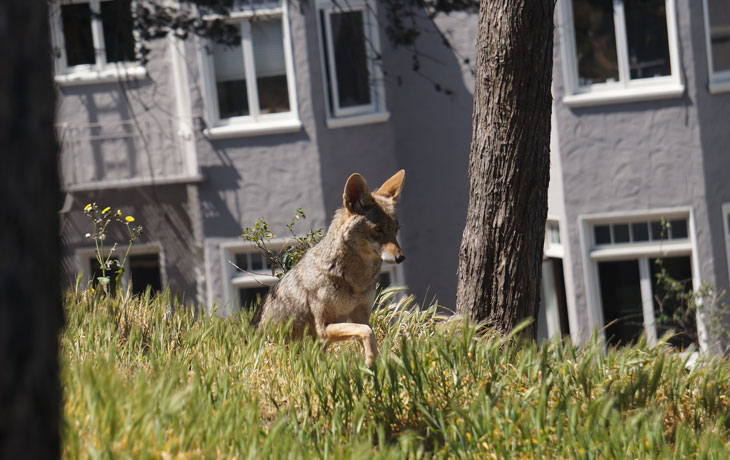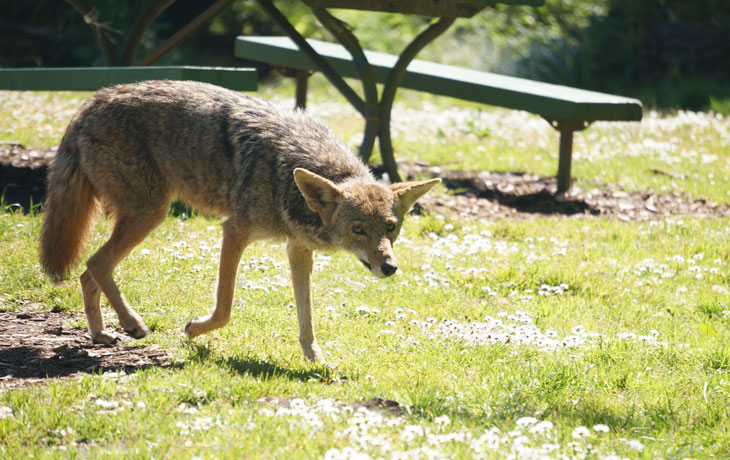Fostering Coexistence With San Francisco’s Urban Coyotes
Coyotes are arguably the most maligned and polarizing wild animal to inhabit San Francisco.
Some residents have called for their removal from urban spaces, pointing to news reports detailing human-coyote conflict within the city and across the United States. Other animal welfare advocates might maintain that coyotes are part of the natural ecosystem, and the occasional well-meaning resident erroneously thinks feeding these wild animals will help them to survive the urban landscape.
State law prevents San Francisco Animal Care & Control (SFACC) from removing or relocating coyotes, which means that these intelligent and adaptable predators will likely continue to survive and thrive in this spatially complex urban environment. While SFACC tries to promote peaceful coexistence between coyotes and city residents, a new analysis of coyote sighting data shows that human-coyote conflict reports have increased over the past five years.
Published last week in People and Nature, the study, which draws on nearly 4,000 community reports of coyote sightings submitted over a decade, found that San Francisco residents have reported increased instances of conflict—particularly among dog owners—and increases in coyote sightings outside of the dawn and dusk hours.
Lead author Christine Wilkinson, PhD ’21 Environmental Science, Policy, and Management (ESPM), said the findings could offer urban wildlife managers insight that can inform future management strategies. “Knowing how human-coyote conflict reports have changed over time and across space, we might be able to predict how conflict might play out in the future.”
Analyzing a decade of coyote sightings
Coyotes are native to California and were found throughout San Francisco until the early 1900s when poisoning, hunting, and habitat loss led to their local extinction. SFACC spokesperson Deb Campbell, one of the study’s co-authors, estimates that the species returned to the Presidio in the early 2000s and that there may now be dozens—but no more than 100—coyotes living in the city.
To help understand species behavior, SFACC began collecting phone and email reports of coyote sightings in 2006. The agency made a more concerted effort to advertise the hotline as reports increased before standardizing the form—and adding an option to submit reports online—in 2017.
“We’ve heard from people who are absolutely outraged about coyotes and afraid of being attacked to people who love seeing them and think they’re these magical creatures,” Campbell said. “Our animal control officers often deal with both ends of the spectrum and everything in between.”
SFACC received reports of nearly 4,000 coyote sightings between 2012 and 2022, according to Wilkinson, who is currently a postdoctoral researcher in the lab of ESPM professor Christopher Schell. The authors classified each report to describe the location and number of coyotes involved; specified if conflict (either realized or perceived) occurred or not; and detailed the nature of reported interaction, opinions, feelings, and attitudes. They also noted if the reporting party had a dog, and whether the owner was adhering to the city’s local leash laws.
Analysis of this dataset showed that human-coyote conflict reports and non-conflict reports (typically sightings) increased over the past decade. While the hours immediately after dawn continue to have the most reported conflict, reports of conflict and non-conflict have shifted over time to include more occurrences during midday, relative to earlier years. Approximately 84 percent of conflict reports reference what community members perceived as bold behavior by the coyote, and 11.7 percent of reports mention coyotes perceived to be growing bolder, becoming more numerous, or frequenting particular areas more often than normal.
The authors also found that the proportion of conflict reports submitted to SFACC increased during the pup-rearing seasons (April to June), dry seasons (June to September), and throughout the COVID-19 pandemic (2020 to 2022). In addition, 78 percent of conflicts reported between 2012 and 2022 involved a dog, with nearly one in five dog-related conflict reports involving an off-leash dog. “These reports range from dogs chasing coyotes, coyotes chasing or biting a person’s dog, or people with dogs being followed by coyotes,” Wilkinson said.
According to the study, reports of conflict were more likely to occur in wealthier areas, with both overall sightings and conflict reports not as frequent in lower-income areas. Schell, the study’s senior author and an urban ecologist whose research focuses on how wildlife adapts to cities, said this distribution is likely reflective of both the built environment and socioeconomic factors.
“Prior studies have similarly shown that the folks reporting animal sightings or participating in community science efforts tend to be wealthier, whereas low-income folks are either less likely to report a coyote encounter, either due to low species abundance or lack of access to and knowledge of reporting platforms,” he said. “There also tends to be less green space in the city’s lower-income areas, which makes it less likely for coyotes to be found there.”
Attitudes and Insights
According to Wilkinson, people who submitted conflict reports were significantly more likely to express negative opinions toward coyotes than those who sent in non-conflict reports. However, 36 percent of reports that expressed a negative opinion about coyotes also expressed a positive opinion, and 5 percent included a concern for coyote well-being.
Campbell said the department regularly receives reports of people feeding the city’s coyotes, which leads to the animals developing bold behaviors that could increase the chance of conflict. SFACC recently received a video of three coyotes walking back and forth by an occupied car. Campbell said the person in the car believed that the coyotes had trapped them and were preparing to attack.
“But after watching the video, it was apparent—at least to those of us who know coyotes—that they were looking for food,” she said. “Somebody must be feeding them from a car or tossing food out, which led these animals to sniff the ground near the car in search of food.”
When responding to reports of coyote sightings, Wilkinson said it’s important for wildlife managers to understand the real and perceived conflict associated with each encounter. These experiences often influence the behaviors people have toward wildlife and the conservation measures they support.
“You have to keep in mind that a lot of human-wildlife conflicts are underpinned by people's values, perceptions, and disagreements with choices made by wildlife policymakers,” Wilkinson said. “For example, if there has been unsupported top-down decision making in the past, people might feel animosity toward wildlife and be unwilling to support certain coexistence measures.”
The study offers urban wildlife professionals important insight that can inform future management strategies and help city residents more effectively coexist with coyotes. According to Wilkinson, SFACC is adjusting its online coyote sighting form to better capture detailed information relating to human-coyote conflict.
Other recommendations include thinning vegetation in areas near potential conflict sites; revising signage in parks to better inform people of coyote behavior and how to report sightings; and targeted educational campaigns that focus on coyote ecology, behavior, dog safety, and how to secure outdoor attractants like food and garbage.
“This was a really special opportunity to be able to collaborate with an agency of first responders to a lot of the urban wildlife issues in San Francisco,” Wilkinson said. “I’m hopeful that these findings can be useful to improve on-the-ground coexistence.”
Additional co-authors include ESPM postdoctoral researcher Lauren Stanton and UC Davis PhD candidate Tal Caspi. The study was supported by Schmidt Science Fellows, in partnership with the Rhodes Trust, and Rausser College of Natural Resources.
